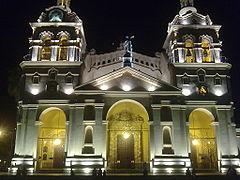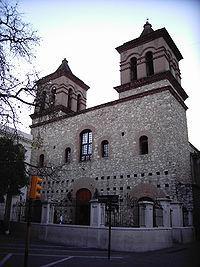Córdova, Córdoba, Argentina
Suggest Place to Visit
3988
Track to location with GPS |
 |
The block is located in the heart of the city. The streets that surround it are Duarte Quirós, Avenida Vélez Sarsfield, Caseros and Obispo Trejo. On the latter are the respective incomes to each of the places that make up the block. This street bears that name in honor of Fray Fernando Trejo y Sanabria.
The geographical location of Córdoba made it a strategic point in the Spanish conquest plan. Depopulation and disintegration were frequent at that time, therefore it was necessary to strengthen the occupation, a function that the church fulfilled.
In 1570, Pope Saint Pius V created the diocese of Tucumán, which included Tarija (Bolivia), Jujuy, Salta, Tucumán, Santiago del Estero, Catamarca, La Rioja and Córdoba. The Franciscan Fathers were the first to arrive. The first bishop of the new diocese was Fray Jerónimo Villacarrillo, a member of that congregation. Likewise, the first priest and vicar of Córdoba was the lawyer Francisco Pérez Herrera, who was also a military chaplain of the conquering expedition of Jerónimo Luis de Cabrera.
Córdoba belonged to the Jesuit province of Paraguay. The first Jesuits arrived around 1589, officially establishing themselves in 1599, in this way Córdoba became the central point of evangelization tasks for the Society of Jesus. In that year the Superior of the order, Father Juan Romero, accepted (on behalf of the company) the donation of the property of which the current Jesuit block is part.
The religious Order founded the Novitiate in 1608 and the Colegio Máximo in 1610. In 1612 the latter was momentarily transferred to Santiago de Chile. The Colegio Máximo, which until 1613 taught Philosophy and Theology classes in Santiago de Chile, is transferred to Córdoba as a result of the idea that the bishop of Tucumán, Fray Fernando Trejo y Sanabria, had to provide the city with a house of higher studies. For this, he donated his future salaries under a notarized promise to complete forty thousand pesos. This sum was equivalent to 5,000 mules or around 200 slaves, which is why the National University of Córdoba is also known as La casa de Trejo. That same year, Bishop Trejo y Sanabria founded the other conviction of the time, that of San Francisco Javier, which would last only until 1617, after which its building was occupied by the Novitiate of the Company. Trejo died in 1614, and the Jesuits are known to have received a quarter, yet they financed and completed the work. Ultimately, the Colegio Máximo derived in 1613 the University of Córdoba (now the National University of Córdoba), the fourth oldest in America.
The Jesuit Block of Córdoba (Argentina) is a block located in the heart of Cordoba.
The Jesuit Block was declared a World Heritage Site by Unesco in 2000.
Comments
We don´t have yet any comments about:
Jesuit apple
Jesuit apple
Be the first to leave a comment as it is very important to inform other people
Outros locais a visitar
Within a radius of 20 km from:Jesuit apple
Igreja de Nossa Senhora da Assunção |
| 0,3 Km |
 |
Cripta jesuíta |
| 0,6 Km |
 |
Hotel reservation near Jesuit apple within a radius of 20 km
Why to book with ROTAS TURISTICAS
The best prices
Our partnerships with the world´s largest operators offer research on the best market prices.
More options
At Rotas Turisticos you can book the hotel, buy the air ticket, book the transfer from the airport to the hotel and vice versa, book the local excursions, rent the car, take travel insurance and consult the places to visit and where to go.
Holiday Tips & Destinations
Hundreds of holiday destinations with all the options that allow you to easily choose the destination that best suits your dream vacation.
ROTAS TURISTICAS
Links






